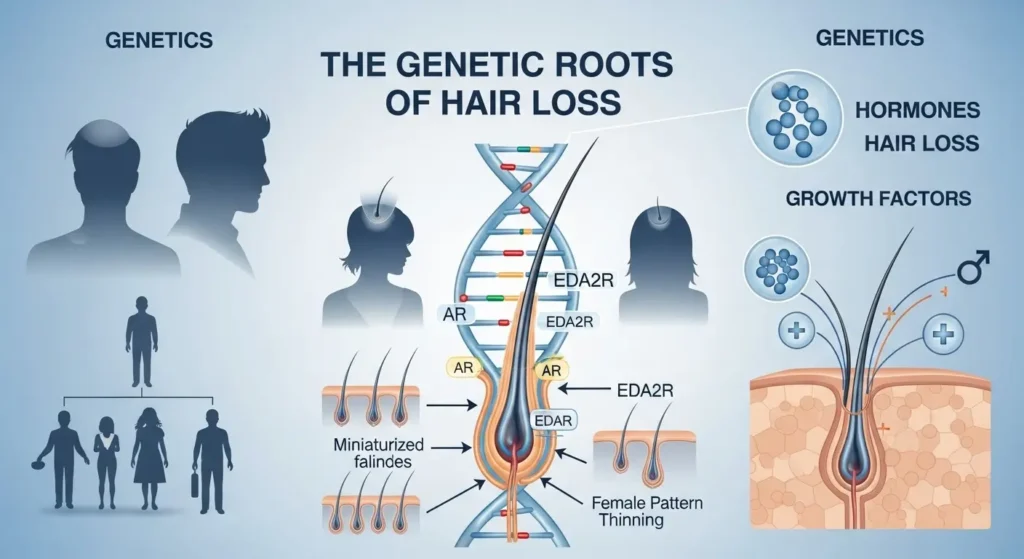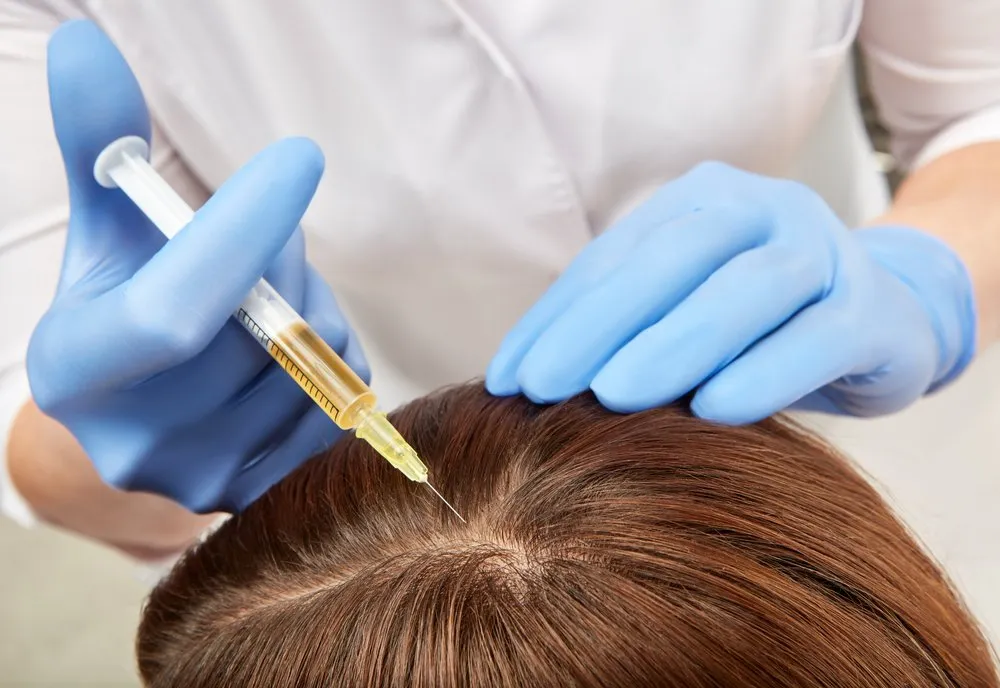Worried your hair thinning might be written in your genes? A DNA test for hair loss can help you discover if you’re genetically predisposed to conditions like pattern baldness and guide you toward tailored, science-backed solutions.
In this article, you’ll learn how these tests work, what the results really mean, and how to use them to make informed decisions about prevention and treatment. With expert insights and medical research, we’ll help you understand your risks and take proactive steps for healthier hair.
Understanding the Role of Genetics in Hair Loss

Hair loss affects millions worldwide, but the causes aren’t always the same. Genetics plays a major role in conditions like androgenetic alopecia (pattern baldness), though lifestyle and environmental triggers also contribute.
What Is Androgenetic Alopecia?
- The most common form of hereditary hair loss.
- Driven by sensitivity to dihydrotestosterone (DHT), linked to the androgen receptor (AR) gene.
- It can begin as early as the late teens or early 20s in men, later in women.
Types of Hair Loss with Genetic Links
- Male and female pattern baldness is the most common genetic type.
- Alopecia areata – autoimmune in nature but influenced by genetic susceptibility.
- Diffuse thinning – may also have hereditary components.
Environmental & Lifestyle Factors vs Genetic Predisposition
Even with a strong genetic tendency, factors like diet, stress, hormonal imbalance, and smoking can accelerate hair loss. Genetics sets the stage, but lifestyle often determines how quickly symptoms appear.
How Does a DNA Test for Hair Loss Work?
DNA tests for hair loss analyze specific genes linked to balding risk and treatment responsiveness.
Sample Collection Methods
- Cheek swab (most common—painless and simple).
- Saliva kits are mailed to a lab.
Common Genes & SNPs Analyzed
- AR gene (androgen receptor) – linked to DHT sensitivity.
- Chromosome 20 variations – associated with higher baldness risk.
- SOD2 and EDA2R genes – involved in inflammation and follicle miniaturization.
What Your Report Includes
- Risk scores for male/female pattern baldness.
- Predicted response to treatments like minoxidil or finasteride.
- Nutrient needs for healthy hair (iron, biotin, vitamin D).
Benefits of Getting a DNA Test for Hair Loss
- Early detection – identify genetic risk before visible thinning.
- Personalized treatment – avoid generic solutions; choose medications or therapies that fit your profile.
- Save time and money – reduce trial-and-error with ineffective products.
- Lifetime insights – your DNA doesn’t change, so results remain valid.
Interpreting Your DNA Test Results
DNA test results are not “yes or no.” They provide probabilities.
Understanding Risk Scores
- Results show likelihood, not certainty.
- Example: “60% higher risk than average” means predisposition, not inevitability.
Lifestyle & Treatment Actions Based on Results
- If you’re high risk: start early with proven therapies (minoxidil, finasteride, PRP).
- If you’re low risk: monitor regularly but focus on diet, stress management, and scalp care.
Consulting a Specialist: What to Ask
- “Am I a candidate for preventive medication?”
- “Which treatments match my genetic profile?”
- “How often should I monitor my hair health?”
Next Steps: From DNA Insights to Action
- Lifestyle adjustments: balanced nutrition, stress control, and avoiding smoking.
- Recommended treatments: medications (minoxidil, finasteride), supplements, PRP, or hair transplant.
- When to seek help: noticeable shedding, receding hairline, or family history of baldness.

Frequently Asked Questions (FAQs)
Can a DNA test guarantee hair loss or regrowth?
No, results only show probability, not certainty.
Will results change over time?
Your genetic profile remains constant, but environmental factors still play a role.
How accurate are DNA tests for hair loss?
They explain about 30–40% of the variability in baldness. Useful, but not absolute.
Are these tests worth the cost?
For many, yes—especially if you want personalized treatment. Average costs range from $150–$450.
What about data privacy?
Choose reputable labs with strict data handling policies. Ask if they delete samples after testing.
Speak to a Hair Loss Specialist in Islamabad
Ready to use science to guide your hair restoration? Book a consultation with Dr. Rana Irfan, an ABHRS and ISHRS-certified leading hair restoration surgeon in Islamabad. With years of expertise and personalized care, he can help you interpret DNA results and choose the right treatment plan.
Conclusion
A DNA test for hair loss offers more than just insight; it empowers you with personalized knowledge for prevention and treatment. While genetics plays a key role, lifestyle and medical guidance shape the outcome. With expert help, you can take control of your hair health today.
